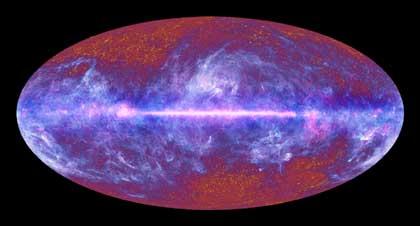The universe from the eyes of the Planck satellite

The telescope of the European Space Agency (ESA) Planck has just offered the most complete image of the universe so far. In addition to providing new evidence on the processes of creating stars and galaxies, the image of the whole sky could serve to study the early phases of the formation of the cosmos. “This is a unique treasure, with lots of new data for astronomers,” highlighted ESA members.
The bright luminous band that can be seen in the center of the image is the Milky Way, the galaxy in which the solar system is located. It is surrounded by a mass of dust and gas, where the stars are formed and die. But what most curiosity arouses astronomers is the background with spots. This is, as reported by ESA, microwave background radiation (CMBR). It is the oldest radiation in the Universe and contains remnants of the explosion that gave rise to the universe 13,700 million years ago. It is one of the most accurate proofs of the Big Bang theory that is spreading throughout the universe.
The Planck satellite began to observe the universe in May 2009. It will surely continue to collect information until early 2012.
Photo: ESA / LFI AND HFI CONSORTIA.
Buletina
Bidali zure helbide elektronikoa eta jaso asteroko buletina zure sarrera-ontzian











